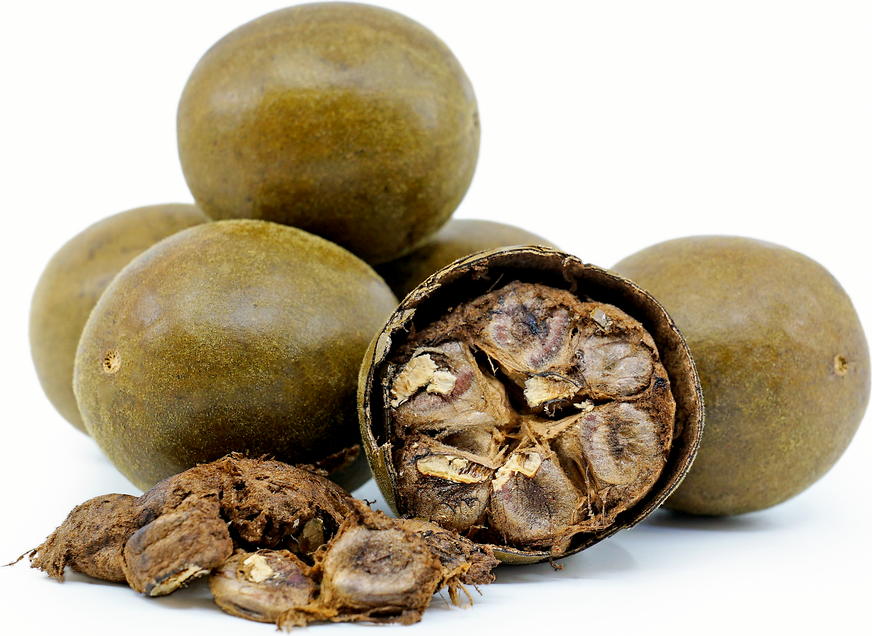


Monk fruit
Estimated Inventory, lb : 0
Description/Taste
Monk fruit is small in size, averaging 5-7 centimeters in diameter, and has a uniform, round to oval shape. The smooth rind is green and firm when fresh, sometimes covered in fine hairs, and as it is dried, it transforms into a brown hue with a hard and brittle consistency. Underneath the dried, thin shell, the pulp is also brown and delicate, encasing elongated and round, brown seeds. Monk fruit is predominately utilized dried and has a very sweet flavor mixed with a subtle astringent aftertaste.
Seasons/Availability
Monk fruit is available year-round.
Current Facts
Monk fruit, botanically classified as Siraitia Grosvenorii, is a small fruit that grows on climbing vines that can reach over five meters in length and belongs to the Cucurbitaceae family. Mainly found in China, Monk fruit is commonly grown by hand on small family farms and thrives in sub-tropical regions along mountainsides. Despite its popularity as a global herbal aid, Monk fruit is difficult to grow, ferments quickly, and is highly perishable, only offered fresh on rare occasions in local markets around the farms in China. Outside of the local markets, Monk fruit is predominately dried and is sold in pieces or is ground and marketed as a healthy sweetener.
Nutritional Value
Monk fruit contains mogrosides, which are natural antioxidants that give the fruit its sweet flavor and are approximately two hundred times sweeter than sugar. This flavoring provides a sweet taste without elevating blood sugar levels. Monk fruit is also a good source of vitamin C, which helps boost immunity within the body.
Applications
When fresh, the pulp of Monk fruit can be consumed, but the fruit spoils quickly and must be eaten immediately after harvest. Monk fruit is more commonly dried, boiled, and used as a sweetener for drinks and food, found in liquid form, condensed into granules, or made into a powder. When flavoring beverages, Monk fruit can be added to smoothies, teas, coffee, and lemonade and is mixed with honey for added flavor. The fruit can also be incorporated into soups such as pork shank or watercress, or it can be mixed into sauces, cereals, brownies, cookies, and salad dressings. In China, Monk fruit is popularly used during the Chinese New Year to make a green tea monk fruit jelly mooncake. Monk fruit pairs well with almonds, ginger, dates, carrots, cabbage, watercress, butternut squash, and mushrooms. Dried Monk fruit will keep up to three years when stored in a cool, dry, and dark place.
Ethnic/Cultural Info
Monk fruit, known as Luo Han Guo in China, has traditionally been used as an herbal remedy for coughs, sore throats, and stomach ailments. Believed to have been first cultivated and named after monks in the 13th century, Monk fruit is used in traditional Chinese medicine as a cooling ingredient to reduce the temperature in the body caused from inflammation, fevers, and weather. Drinking the fruit in a tea or in a soup is also believed to act as an anti-inflammatory and reduce phlegm.
Geography/History
Monk fruit is native to Asia, specifically Southern China and Thailand, and was first cultivated in China in the 13th century. The dried fruit and seeds were then introduced to the United States in 1941 and were also introduced to Australia as a prospective alternative growing region. Today the main cultivation regions are still found in China in the provinces of Hunan, Guangxi, Guangdong, and Jiangxi, and the small farms have partnered with larger corporations to export the dried fruits globally. Monk fruit is almost entirely found on the farms, rarely found growing wild due to its difficult nature, and the dried fruit and sweetener can be found at specialty grocers and online retailers in Asia, Europe, the Americas, and Australia.
Recipe Ideas
Recipes that include Monk fruit. One




